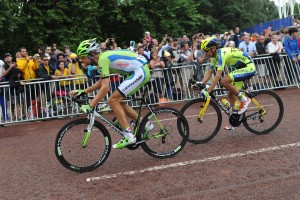Article
Hill climb cars to include beacons | NFC WorldFrom the horse’s mouth
Pikes Peak International Hill Climb
My Comments
This year’s Pikes Peak International Hill Climb in Coloradio Springs, Colorado, USA has become an interesting race when it comes to enriching the spectator’s experience.
It has been facilitated by the use of Bluetooth Beacons or iBeacons along with an iOS 8+ iPhone app which provides detailed up-to-date information about the competitors and where the place during the race. This includes the ability for users to favourite a competitor and be notified when they hit the finish. The Bluetooth Beacon technology is pitched as being Internet-independent because there isn’t the need to have the vehicles equipped with GPS-capable devices and spectators’ smartphones can pick up these beacon signals easily.
But I do see more potential for this in rallies, hill-climb races, road-based cycle races, marathons and similar point-to-point races. This is where competitors are required to race from one point to another and following a known route or series of waypoints. Here, spectators would typically be spread across the (typically long) course and would want to know when their favoured competitors are coming past them as well as knowing how they are placed in the competition.
The same technology can work with other computer systems to accurately determine who has won the race without requiring the use of proprietary transponder technology. As well, there isn’t a requirement for competitors to carry and use GPS devices that need continual mobile-broadband links for uploading real-time position data, something that would be difficult with events held in country areas where such service isn’t all that reliable. The other bonus is that the Bluetooth beacons are very lightweight which adds very little weight to the competitor or competing vehicle where any extra weight carried can slow the competitor down.
But the hillclimb allowed spectators with suitably-equipped mobile devices that supported beacon detection to detect these beacons themselves when it comes to when “their” competitors are near. As well, computing devices with Bluetooth Smart functionality and Wi-Fi / mobile-broadband Internet access can be located at key points in the course to report the competitors’ positions for real-time updates for broadcast and online use.
It does show that the idea of using the Bluetooth Beacon technology for tracking the competition in point-to-point races has been proven thus allowing for systems that are more affordable for providing real-time competition updates for the spectators. It could be that as you watch that car rally you could have you phone notify you when that rally legend is near and about to perform that 3-point turn in the WRX. Similarly, your phone would notify you as the Tour De France péléton is about to arrive in your street so you can flip open those shutters and windows on the front of your house to have a look as it comes past.
For it to work effectively, the Bluetooth Beacon technology needs to be able to work on the client side with iOS, Android and Windows platforms with the necessary client apps written to work on each of those platforms.

![VW Golf 3rd Generation rally car in Saxony rally by André Karwath aka Aka (Own work) [CC BY-SA 2.5 (http://creativecommons.org/licenses/by-sa/2.5)], via Wikimedia Commons](https://homenetworking01.info/wp-content/uploads/2015/07/Saxony_rally_racing_VW_Golf_3_55_aka-300x162.jpg)


